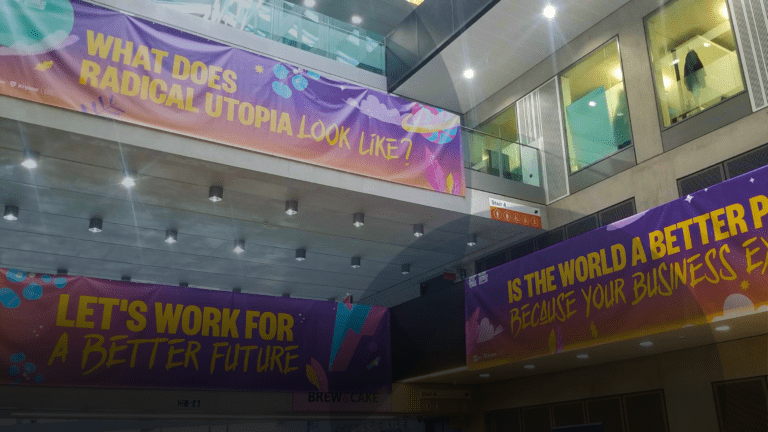
Charlie Stewart
Content Strategist
Charlie brings his creative flair developing content and copywriting across all of our campaigns.

If you work in tech, finance or many other sectors, you might struggle to find ways to tell your business' story. Here's how you can always find stories to tell.
There’s always a story. It’s all stories, really. The sun coming up every day is a story. Everything’s got a story in it.
Terry pratchett
Two fish are swimming in the sea.
“Water’s warm today,” says one. The other looks confused.
“What’s water?”
It can be hard to notice something when you’re surrounded by it.
It doesn’t matter if you’re in finance, energy, biotech – whatever sector you’re in, you are surrounded by stories!
Learn how to spot them, and you’ll supercharge your content, build trust with your audience and meet your marketing goals.
Most stories you use will come from one of two places.
Let’s take a look at some examples.
Before we dive into how you can start telling internal stories for your sector, take a look at these examples from our clients. Through their social, we use internal storytelling to work towards goals like recruitment, staff wellbeing and awareness.
Now, imagine you work for a retail franchise called MacDougal’s.
You have reached out to several existing franchisees, hoping to find material for good stories.
One of these franchisees is named Helen. Helen first joined the company as a retail assistant when she was a teenager. In fact, it was her first job. After working at the company for fifteen years, Helen was offered the opportunity to run her own site as a franchisee. Later on, Helen took over another two sites.
Here’s how you could use Helen’s story to motivate prospects to consider opening a franchise, on a social media post:
Helen first stepped foot in a MacDougal’s looking for her first job. Fifteen years later, she owns three of our sites and employs over 50 people.
Looking to run your own business with MacDougal’s? Apply on our website today.
It might be short, but pair that with a picture of Helen beaming in front of one of her sites and you’ll have turned a simple piece of information into a story about success and the enticing opportunities MacDougal’s offers.
Imagine you work for a London-based cleaning company named Sweep Dreams which, last year, became employee-owned.
Not only do the employees now own the majority of shares, but an employee council has also been established to represent their voices. You talk to one of the younger employees, Maya, who has become a member of the employee council.
Recently, the council voted to support London Cancer Support, a charity. While speaking to Maya, you jotted down a few quotes.
Here’s how you could announce the new charity partnership while bringing Maya’s story to the forefront and helping you meet your goals.
“Employee-ownership doesn’t just help people inside our business – it helps us have an impact on everyone. I’m so glad we recently voted to help people in the communities we work in.”
Maya joined the Sweep Dreams team three years ago. When we became employee-owned, she joined our employee council. Along with her fellow council members, she is excited to announce our new charity partner: London Cancer Support.
Pair that with a picture of Maya and the employee council – or, better yet, Maya directly involved in charity work – and you’ve got yourself another simple but effective story.
Internal storytelling is about narrativising the information you already have. That can be easier said than done. If you get stuck, here are three tips you can use to get started:
To tell a story effectively, you have to draw out a character to focus on and make the stakes compelling. Then, grab your audience’s attention by subverting their expectations. Like in the stories above, this is possible in just a couple of lines.
If you’re able to do that, you’ll be off to a great start. These are tricks storytellers have used for thousands of years.
Think of how important the first line of a book is to keep you reading. Think of how many stories from mythology make characters out of animals, natural phenomena like storms, and even concepts like love and envy.
But what if you have an important point to make, but you can’t find a story from inside your company? That’s where external stories come in.
You’re most likely to use external stories to show your expertise when talking to an audience that’s already familiar with your business. This might be a thought leadership article or post you’re writing, in a marketing email, in a book you’re writing on your sector – wherever you’re making a larger point about your industry! Let’s dive in to some examples.
Imagine you work for a management consulting firm.
To do this, you’re aiming to make your CEO a respected thought leader using social media.
Here’s a story your CEO could tell on social media to help meet that goal:
The French military commander and political leader Napoleon Bonaparte faced one of his greatest triumphs and one of his greatest failures just a month apart.
He was a famous micromanager. This worked well on land, where he could send messages to his men with ease. His eye for detail helped the French win an overwhelming victory at the Battle of Austerlitz.
The Battle of Trafalgar, however, was fought at sea. There, distant ship captains needed to be able to make their own split-second decisions. The French suffered a crushing defeat.
To overcome challenges in any terrain, you need to know when to take control and when to empower your team…
Imagine you work for a marketing agency, with many clients in the tech sector.
As with the previous story, your business goal is to gain more clients and your marketing goal is to promote your team’s expertise. Here’s a story a team member could tell to do just that:
In the 1970s, computer scientist Grace Hopper was working on a new programming language that would be easier for ordinary people to use.
At the time, most programming languages used complex mathematical notation. In contrast, Hopper’s new language used plain English words and phrases to describe programming concepts, such as “IF…THEN…ELSE” statements.
Hopper’s innovations weren’t always welcomed by her male colleagues, who saw her language as “dumbing down” programming. In response, Hopper famously said, “I’m not trying to make the language more complex, I’m trying to make it more accessible.”
Innovation isn’t about making things more complicated. It’s about making things simpler. That’s why we’re dedicated to making your message easy to understand.
Like internal stories, external stories often start with a focus on one character, and kick off with a surprising twist. In our first example the character is Napoleon. The twist is that such a great victory and defeat took place so close to each other.
However, as our second example shows, you don’t have to follow this formula – these are just techniques to help you get started. You can tell stories in many different ways to meet many different goals.
External stories aren’t directly about your organisation. Instead, they are an opportunity to introduce storytelling to an otherwise dry point. In this case, that point is the importance of delegating.
There are plenty of situations where you can use an exterior story to demonstrate your point, but be careful. It’s sometimes easy to get carried away with a story, without realising that it doesn’t quite make the point you want it to.
Your story needs to contain your key message.
My previous article on storytelling contained a version of the following story:
Mike was on the cusp of a breakthrough which would kickstart his meteoric rise from underdog to alpha male. All it would take was two cans of kerosene.
Mike was a chimpanzee under Jane Goodall’s observation at the Gombe Stream Research Centre in the 1960s. He was at the bottom of the pecking order, bullied by the rest of the troop.
In her book In the Shadow of Man, Goodall recalls the day that Mike’s social status changed for good. Having collected two kerosene cans from the nearby research camp, he approached the other males and their leader, Goliath. Slowly, Mike began banging the cans together. The din grew into a cacophony. Then, he charged. Terrified, the other chimps scattered. None of them gave Mike trouble after that.
Using tools isn’t unique to humans. It’s been observed across the animal kingdom, from crows to octopuses. Neither are complex social structures or rich emotional lives.
But before Jane Goodall, the social lives of chimps were a mystery. Her work didn’t just deliver insights into their world. It transformed them in the popular consciousness from animals into underdogs, heroes, even warring tribes. It was a revolution in primatology, but also storytelling. Without Goodall’s work, Mike and his kerosene cans would be long forgotten. So what is it that sets us apart from our closest cousins?
Humans have evolved an impulse to share stories.
In your marketing, stories are one of your most powerful tools.
It’s an interesting story, but does it fit the point we’re trying to make? Let’s say the point we’re trying to make is this:
Stories build trust. Trust builds social networks.
Mike’s story is compelling and it could be used to make plenty of points:
However, Mike’s story doesn’t as clearly make the point “Stories build trust. Trust builds social networks” even though it could be used to make that point in a roundabout way.
Your story has to serve your message, not the other way around.
To tell the right story, you need to understand your key message.
That means boiling down your main point to just one or two short sentences. You can do this by looking back at your goals.
Then, you need to boil down the point of any story you’re considering telling in the same way. If they don’t match one for one, you’ll need to find a different story or figure out a different way to tell it.
The fact that the story about Mike needs several paragraphs to link it to the key message is evidence that it might not be the right fit. If you can’t tell your story succinctly and easily link it to your message, it might not be the right choice.
Your stories don’t need to be non-fiction and they don’t need to be long. Take a look at the story we started with:
Two fish are swimming in the sea.
“Water’s warm today,” says one. The other looks confused.
“What’s water?”
It can be hard to see something when you’re surrounded by it.
You are surrounded by stories.
This is just an old joke, but it sets a scene, it gives us characters and it has a fun twist. It’s everything we need to cut to the chase and dive right in.
Here are some other places you can draw inspiration, with example stories for each.
I can’t stand sweetcorn.
It’s not sweetcorn’s fault. There’s just something about it. Even when it’s buried under a mountain of other flavours, just knowing it’s hiding in there is enough to make my stomach turn.
A lot of people have that one food they detest. It can border on a phobia. Matters of taste are hard to rationalise. For someone else, that food you can’t stomach could be a delicacy.
This poses a major problem for marketers: there’s nothing more subjective than the act of consumption…
It was the height of the space race, and NASA had a problem.
Pens don’t work in zero gravity. A brief panic and several thousands of dollars of R&D later, and voila! NASA had invented a pen that worked in space.
The Russians used a pencil.
Sometimes, we get so bogged down trying to get our approach to work that we can’t see a simple solution…
In April 2012, the video game company Electronic Arts won the “Worst Company in America” award with over 50,000 votes.
EA spokesperson John Reseburg was having none of it:
“We’re sure that bank presidents, oil, tobacco and weapons companies are all relieved they weren’t on the list this year. We’re going to continue making award-winning games and services played by more than 300 million people worldwide.”
The next year, EA won the award again.
When your customers are telling you something, listen…
On the day of his death, doctors had drained George Washington of almost half of his blood.
It’s easy for us to look back on the medical practices of the past with disbelief, but in some cases bloodletting can help people. Even today, you can take a turn off the M4 just ten miles out from Swansea and find Biopharm Leeches, the NHS’s official leech provider.
By drawing blood, leeches prevent blood from coagulating and speed up the healing process. This might lead to an incorrect assumption – draining blood helps a patient heal.
Sometimes, someone having a small amount of knowledge is worse than knowing nothing at all. We always risk turning one correct observation (like bloodletting speeding up the healing process) into an incorrect assumption (that draining half of someone’s blood will heal them even quicker)…
These are examples to get you started.
Some of these stories can also be reworked from different angles to make different points.
Take a turn off the M4 just outside Swansea and you’ll find Biopharm Leeches, the NHS’s official leech provider.
Most of us think of medical leeches as a thing of the past. The truth is, they still work wonders. Leeches prevent blood from coagulating and speed up the healing process.
As the old saying goes, if it ain’t broke, don’t fix it. That’s true in our industry as well…
Even if you’re writing stories about events in and around your business, you can still apply some of the same techniques these stories use to make them more enticing.
However, although there will be plenty of stories you can tell that come from within your business and your clients, keep this quote from marketing consultant and NYT bestseller Jay Baer in mind: “If your stories are all about your products and services, that’s not storytelling. It’s a brochure. Give yourself permission to make the story bigger.”
When Steve Jobs announced the Apple Macintosh, his speech included this line:
“IBM wants it all and is aiming its guns to its last obstacle to industry control. Apple. Will Big Blue dominate the entire computer industry?”
This is a perfect example of making the story bigger. It tells a story about giants and underdogs, freedom and control, monopoly versus innovation.
Mediocre speeches begin “I’d like to start by telling a story.” Great speeches have a story infused throughout that delivers their point with an emotional punch.
Remember that storytelling taps into a fundamental part of the human psyche. It’s how we’ve made friends, given warnings, created coherent social groups, and understood the world around us for thousands of years.
We see our world in stories. Our perception is always limited, always narrativised, and always infused with emotion.
You’ll need a portfolio of great work to market your business, but your competitors will have that too.
To come out on top, you need to tell the better story.
Want to get in touch about content marketing? Drop me an email at [email protected].

Content Strategist
Charlie brings his creative flair developing content and copywriting across all of our campaigns.
View my other articles and opinion pieces below
This is an article to help you get better at story-driven marketing within your organisation or for your clients. I’m not talking about your old school wishy-washy once upon a time style storytelling. This is about drawing out the kind of authentic stories your colleagues (or clients) don’t even know they’re hiding. It’s about getting […]

Ask yourself these questions. These are two examples of actions taken by speakers at the Better Business Conference in Manchester last week, which I had the opportunity to attend. While I understand the motivation behind both approaches, I also respectfully disagree with them. In this article, I want to attempt to explain why, and to […]

You want to use AI to write content quickly. But here’s the problem. ChatGPT isn’t great with straight facts. It’s more interested in creating something that looks like a well-researched piece of content, but when you get into the nitty gritty, you’ll find that a lot of the details are incorrect or the descriptions very […]

Everybody wants their content to get to the top of Google Search results. To get to the top of Google Search results, you need to understand Google’s Helpful Content Update. The Helpful Content Update priorities content which is original, insightful and therefore helpful to users. If you were hoping to use AI to write great […]
